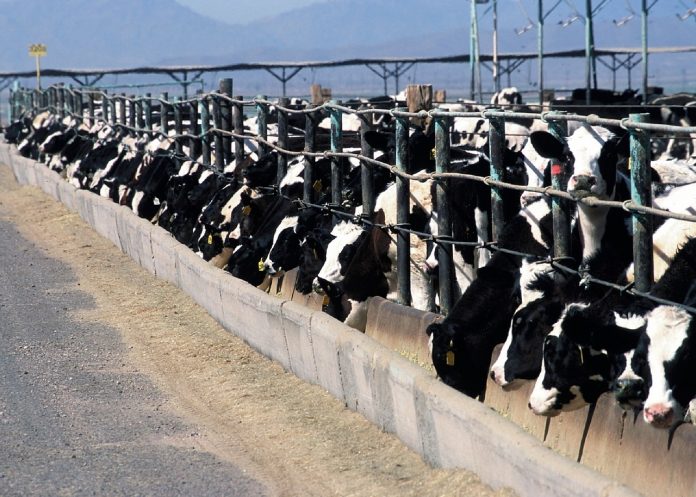It’s that time of year when the hands are rather chapped from the cold conditions of the winter. For farmers, that often means hands in frequent contact with water, especially for dairy farmers, so an ample supply of hand cream is important to keep around.
Very high on the list of ingredients in hand cream is glycerin — another name for “glycerol.” You also will find it in teat or udder ointment. Glycerol is an odorless, colorless, and sweet tasting viscous liquid. It is the backbone for fatty acids to form fat. Fat from soybeans, tallow, restaurant grease, etc. is used for many purposes. When the fat is isolated and further processing occurs through hydrolysis, the results are fatty acids and glycerol. The glycerol can be fed as an energy source to dairy cattle.
In the March issue of the Journal of Dairy Science, Canadian researchers fed 0 or 250 grams/day of a powdered glycerol supplement (60% glycerol) to dairy cows 21 days prepartum and 0 or 250 g/day of the supplement for 21 days postpartum. Cows were milked in an automatic milking system and so the supplement postpartum was added to the partial mixed ration.
The focus of their study was primarily on feeding behavior. Glycerol supplementation pre and postpartum resulted in less time spent lying down following parturition. Minimal differences between treatments were observed for pre- and postpartum sorting behavior or rumen pH.
Overall, supplementation of glycerol pre- and postpartum altered cow time budgets, with cows spending more time eating pre- and postpartum, less time lying pre- and postpartum and having fewer, larger meals prepartum when receiving glycerol prepartum. Cows also had slower feeding rates and smaller meals following parturition with postpartum glycerol supplementation.
In a study Purdue University conducted a few years ago, 60 dairy cows were fed diets containing 0, 5, or 10% glycerol (replaced corn). The diets contained 31.9% corn silage, 10% alfalfa haylage, 12.2% alfalfa hay and 45.9% concentrate (including the glycerol). Feed intake, milk yield, milk fat and milk protein were similar among the dietary treatments, 53.5 pounds/day, 81.2 pounds/day, 3.60%, and 2.85%, respectively.
Concentrations of milk urea nitrogen were lower with diets containing glycerol, and cows consuming 10 or 15% glycerol gained more weight than cows not fed glycerol. We conducted a study at OSU whereby 48 cows — averaged 112 days in milk — were fed different concentrations of glycerol and non-fiber carbohydrates:
1) 0% glycerol and 37% NFC,
2) 5% glycerol and 37% NFC,
3) 10% glycerol and 37% NFC, or
4) 10% glycerol and 42% NFC. Diets contained 37.4% corn silage, 9.1% hay and 53.5% concentrate, including the glycerol.
Feed intake, milk yield, milk protein and milk urea nitrogen were similar among the dietary treatments: 52.6 lb/day, 87.1 lb/day, 3.06%, and 14.3 mg/dl. Milk fat percentage was decreased with glycerol addition — 3.52, 3.18, 3.19, and 2.93%, respectively — especially when 10% glycerol was fed with 42% NFC.
In each of these production studies, cows were fed the diets for eight weeks — and based on the results from these two studies and other published research — we can conclude that glycerol has value as a feed ingredient for dairy cattle. Feeding glycerol at 5 to 10% of the dietary dry matter should be valuable nutritionally and should pose limited risks to animals. Given the viscous nature of the product, it has been advocated as possibly helping to reduce sorting of total-mixed rations by dairy cows.
However from the Canadian study, glycerol did not impact sorting behavior, but animal response to feeding glycerol may be partially explained by other changes in feeding behavior.
It is important to keep in mind that the studies described above were conducted using food-grade glycerol. Crude glycerol from biodiesel production will contain unused catalyst (e.g. sodium hydroxide or potassium hydroxide), methanol, and salts. The actual amount of glycerol in crude glycerin may range from 75 to 90%. The Food and Drug Administration has issued a letter stating that if methanol is over 150 ppm (0.015%), then it should not be used for animal feed.
Feeding glycerol to dairy cattle can be valuable as an energy source. However, some observations in the Canadian research provide evidence that feeding glycerol could be problematic in situations with high stocking densities or other factors limiting bunk space. Other factors that must be considered is the purity of the crude glycerol and the high cost of feeding pure glycerol. As you reflect on these options, grab some hand cream and treat those hands — you deserve it.













